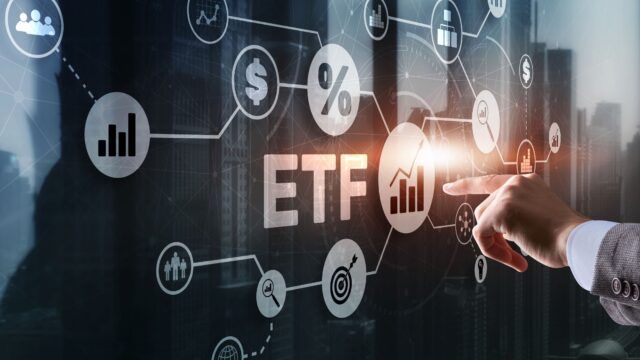Investors are sharply focused on structural shifts in technology, people and demographics, infrastructure development and the physical environment.
Covid-19 accelerated many of these trends. “The pandemic fast-tracked digitalisation, upending deeply engrained social norms and consumer habits, and unlocked new economic policymaking from governments around the world,” explained Jay Jacobs, head of research and strategy at Global X ETFs.
For example, 181 zettabytes of data are projected to be created, captured, copied and consumed around the globe in 2025, more than the figure from 2010 to 2019 combined.[1] At the same time, the total combined market capitalisation of cryptocurrencies recently hit $1.54trn, exceeding silver ($1.35trn) and Facebook ($1.05trn).[2]
In line with these sweeping changes, there is a surge in fund flows towards companies that look poised to benefit from disruptive trends.
This can be seen within the passive investment space; there were 174 thematic exchange-traded funds (ETFs) in the U.S. by the end of the second quarter of 2021, worth a combined $143.2bn in assets under management. This was up 8% on the first three months of the year, and 246% higher than 12 months previously.[3]
Capitalising on a new-look China
These strategies are particularly appealing for investors looking to tap the far-reaching demographic, environmental and behavioural changes in China.
According to Rui Yu, vice president, ETF sales of Global X ETFs, at Mirae Asset Global Investments in Hong Kong, these are being driven by the key objectives in the 14th Five-Year Plan, which include:
- Prioritising quality growth rather than quantity
- Creating a more self-reliant technological and manufacturing economy
- Accelerating the drive towards a low-carbon future
- Achieving “common prosperity” through rural revitalisation and urbanisation strategies
These are expected to create new opportunities for alpha in sectors ranging from biotech, clean energy and electric vehicles to cloud computing, robotics and semiconductors.
“Rapid ageing and urbanisation with a growing middle class in China may provide more incentives to improve operational efficiencies with a higher level of digitalisation, which should lead to increased demand for software and cloud-related spending,” explained Yu.
The way in which consumer behaviour is evolving in the Mainland is playing a key part too. “E-commerce and digital payments are already very popular and heavily adopted in China,” added Yu. “We expect this to accelerate in other areas such as digital health, remote office working and cybersecurity.”
Meanwhile within the energy sector, despite expectations China will still be reliant on fossil fuels in 2025[4], the country’s energy mix is already moving towards its long-term goal of carbon neutrality.
This heralds potentially significant opportunities for investors who understand the rationale and driving forces.
Re-positioning portfolios
Interest in thematic ETFs is also widespread across various types of investors globally, including self-directed retail, intermediaries and institutions. “Retail investors made up a third of inflows into our thematic ETFs in 2020, while industry-wide data suggests retail ownership of ETFs is approximately 40%,” said Jacobs.
This appetite stems from the advantages that many investors identify with thematic investing. Jacobs pinpoints five clear benefits thematic investing can offer investors’ portfolios. These include:
- Looking beyond short-term market indicators such as earnings, guidance and macro trends, and instead, embracing a long-term perspective
- Participating in exponential growth when resisting short-term decisions, which tend to under-value or misprice longer-term opportunities
- Getting ahead of the curve by locking in exposure before mainstream index inclusion and ownership
- Diversifying returns via concentrated baskets of securities and an unconstrained approach by sector and geography
- Avoiding the possibility of disruption as structural changes occur
“Thematic investing is a rigorous and research-driven way to harness structural changes around the world,” he explained.
The process combines a top-down view to identify disruptive macro-level trends, with bottom-up selections of investments that have a high exposure to those trends.
As a result, Jacobs sees thematic investing as most suitable as a satellite position in a growth-oriented portfolio. “Investors need a longer time horizon, and thematic strategies can replace a portion of core or growth equity exposure, keeping asset allocation generally the same.”
[1] Source: Statista, as of June 7, 2021.
[2] Source: Companiesmarketcap.com, Coinmarketcap.com, as of July 28, 2021.
[3] Source: Global X ETFs, Bloomberg, as of June 30, 2021.
[4] Source: International Energy Agency, as of July 30, 2021.
DISCLAIMER
This document is provided for information and illustrative purposes and it is intended for your use only. It is not a solicitation, offer or recommendation to buy or sell any security or other financial instrument. The information contained in this email is intended for Professional Investors (as defined by Hong Kong’s SFO) and has been provided as a general market commentary only and does not constitute any form of regulated financial advice, legal, tax or other regulated service.
The views and information discussed or referred in this document are as of the date of publication. Certain of the statements in this email are our expectations and forward-looking statements. Such expectations, views and opinions may change without notice and are based on a number of assumptions which may or may not eventuate or prove to be accurate. Investment involves risk. Investors are advised to seek independent professional advice before making any investment. We accept no liability for a loss arising from the use of this document.
We are not responsible for the content or accuracy of third-party sites hyperlinked from this document. You agree that neither we nor any of our affiliates shall be responsible or liable, directly or indirectly, for any damage or loss caused or alleged to be caused by or in connection with use of or reliance on any such content, products or services available on such external sites. Accordingly, we disclaim any responsibility for the linked sites.
This document is issued by Mirae Asset Global Investments (HK) Limited and has not been reviewed by the Securities and Futures Commission or the applicable regulator in the jurisdiction which this article is posted and no part of this publication may be reproduced in any form, or referred to in any other publication, without express written permission of MAGI HK.
Copyright © 2021 Mirae Asset Global Investments. All rights reserved.

















